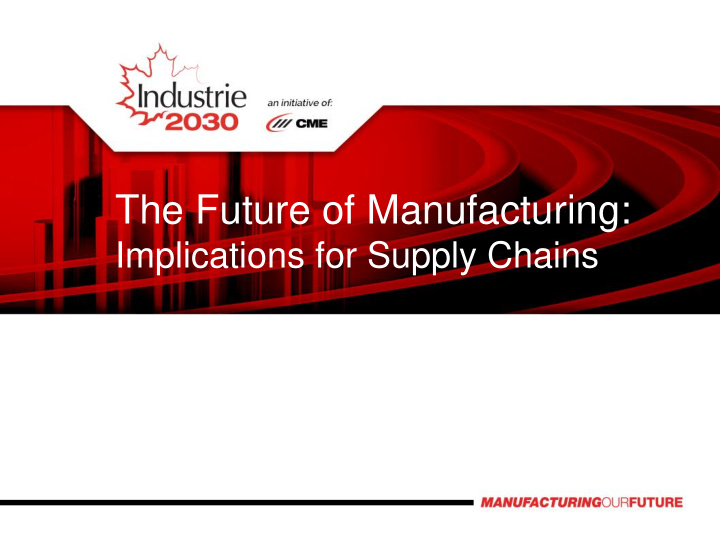



The Future of Manufacturing: Implications for Supply Chains
Manufacturing Matters to Canada A $620 billion industry 11% of GDP (18% in 2004) 1.7 million direct employees (2.2 million in 2004) The largest payroll of any business sector Two- thirds of Canada’s goods & services exports 80% of private sector R&D 85% of patents commercialized in Canada Every $1 of output generates $3.50 in total economic activity ($3.05 in 2004) The business of providing customer solutions combining the production of goods, new technologies, and services
Manufacturing Sales in Canada 60 55 Billions of Dollars per Month 50 45 40 Image Caption if needed 35 2000 2001 2002 2003 2004 2005 2006 2007 2008 2009 2010 2011 2012 2013 2014 2015 2016 2017
Merchandise Export Performance 50 45 40 Billions of Dollars 35 30 25 20 Image Caption if needed 15 2000 2001 2002 2003 2004 2005 2006 2007 2008 2009 2010 2011 2012 2013 2014 2015 2016 2017 Total Exports of Goods Exports excluding Energy
Manufacturing Sales by Province – Feb 2016 20 17.6 13.4 15 12.2 Year-over-Year Percent Change 10 3.9 5 2.4 1.7 0 -2.2 -5 -5.4 -10 -15 -13.8 -16.9 -20 Image Caption if needed -19.8 -25 Canada NL PEI NS NB QU ON MB SK AB BC
Manufacturing Sales by Sector Transportation Furniture Miscellaneous Equipment Electrical Equipment 2% 2% 2% 18% Food 15% Computers & Beverage & Tobacco Electronics 2% 2% Textiles Machinery 1% 6% Clothing 0.5% Fabricated Metal Products Paper 6% 4% Primary Metals Printing 8% 1% Petroleum Products Image Caption if needed Non-Metallic 14% Mineral Products Wood Products Plastics & Rubber Chemicals 2% 4% 4% 8%
Manufacturing Sales by Sector – Feb 2016 Food 7.7 Beverage & Tobacco 4.2 Textiles 5.1 Clothing -12.6 Leather Products 0.9 Paper 4.1 Printing -1.3 Petroleum Products -33.8 Chemicals 1.3 Plastics & Rubber 5.0 Wood Products 9.9 Non-Metallic Mineral Products 6.3 Total Manufacturing 3.9 Image Caption if needed -40 -35 -30 -25 -20 -15 -10 -5 0 5 10 15 Year-over-Year Percent Change
Manufacturing Sales by Sector – Feb 2016 Primary Metals -1.4 Fabricated Metal Products 1.3 Machinery -9.5 Computers & Electronics -3.6 Electrical Equipment 2.7 Transportation Equipment 30.1 (Auto Assembly) 43.8 (Auto Parts) 18.5 (Aerospace) 31.3 (Other) -1.2 Furniture 7.1 Miscellaneous 7.0 Total Manufacturing 3.9 Image Caption if needed -20 -10 0 10 20 30 40 50 Year-over-Year Percent Change
Current Economic Challenges & Opportunities Opportunities Recovery in US consumer demand (?) Competitive Canadian dollar Growth in specialized product markets Infrastructure investments Challenges Currency volatility Oil & commodity price collapse = loss of demand in oil sands and mining developments Financial turbulence Slower growth in China and other “emerging markets” Low/no growth in other major economies Slow growth at home – high risk for consumers /housing market Higher mandatory overheads (tax, user fees, regulatory compliance costs) Regulatory obstacles – federal, provincial, inter-governmental, border, international
Long Term Trends More demanding customers looking for immediate, customized, reliable, competitively priced solutions and expecting interaction with products that can serve a variety of interests More demanding stakeholders – governments, investors, public More intense competition – in both mass produced and specialized/innovative product lines Aging population and skills shortages Social challenges = new business opportunities Health care, climate, environment, food, water, energy, security, social development Digital revolution in manufacturing technologies
A Revolution in Manufacturing Technologies Digital revolution – Computing power growing exponentially, costs of technology are falling Industry 4.0 – Integration of cyber-physical systems Advanced visualization, modeling, and artificial intelligence Reconfigurable, and integrated automation, sensors, robots, lasers, & visual systems enabling product/process monitoring & control, data collection both vertically (from shop floor to top floor) and horizontally (across the value chain) Internet of Things – “Internet of Value” – Real-time connection of products, processes, systems, customers, suppliers, networks of value Big data & quantum computing – Data analysis enabling rapid decisions and new applications & services Additive manufacturing/3-D Printing – Rapid prototyping and mass customization of complex parts Micromachining – Nano-machines, Bio-machines New materials – Lightweight, bio-nano-based, new alloys, printable electronics & smart materials New energy technologies – Generation, storage, propulsion, renewables
The Future of Manufacturing Customers will interact directly with products and design processes. Products will be designed, tested, and engineered for production in cyberspace, using three-dimensional software, virtual and augmented reality Instructions will be sent to smart machines and automated factories to make the products. Software will optimize production processes and information flows across value chains – improving quality, reducing waste, increasing operating efficiencies, and speeding time to market for mass-customized products. Products and processes will be information platforms allowing for life cycle maintenance, monitoring, control, data analysis, and new applications More money will be made from services, data analytics, and apps than from products & production processes.
New Business Strategies are Required Manufacturers will still need to be fast, flexible, efficient, compliant, & reliable They will be producing more customized, complex products requiring greater precision and accuracy Convergence of manufacturing, technology, service business models Focus on customized solutions, not products Value creation from services and data analytics Responsibility for end-to-end product life cycles Collaborative business models across international value chains to reduce risk and develop new opportunities Financing will depend on cash flow & rapid payback – less on asset- based lending
Implications for Supply Chains Premium on customized solutions End-to end speed, efficiency, traceability, solutions, product management Value networks will replace supply chains – reconfigurable product, service, & knowledge networks responding rapidly to changing business conditions and customer demand Greater emphasis on collaborative partnerships for risk reduction, high speed solutions, business development, innovation Prevalence of knowledge based “suppliers” – research centres and technology start-ups Greater degree of localization in high value manufacturing Globalization of information flows Continuing shift in mass production/labour intensive manufacturing to lower wage economies
Recommend
More recommend